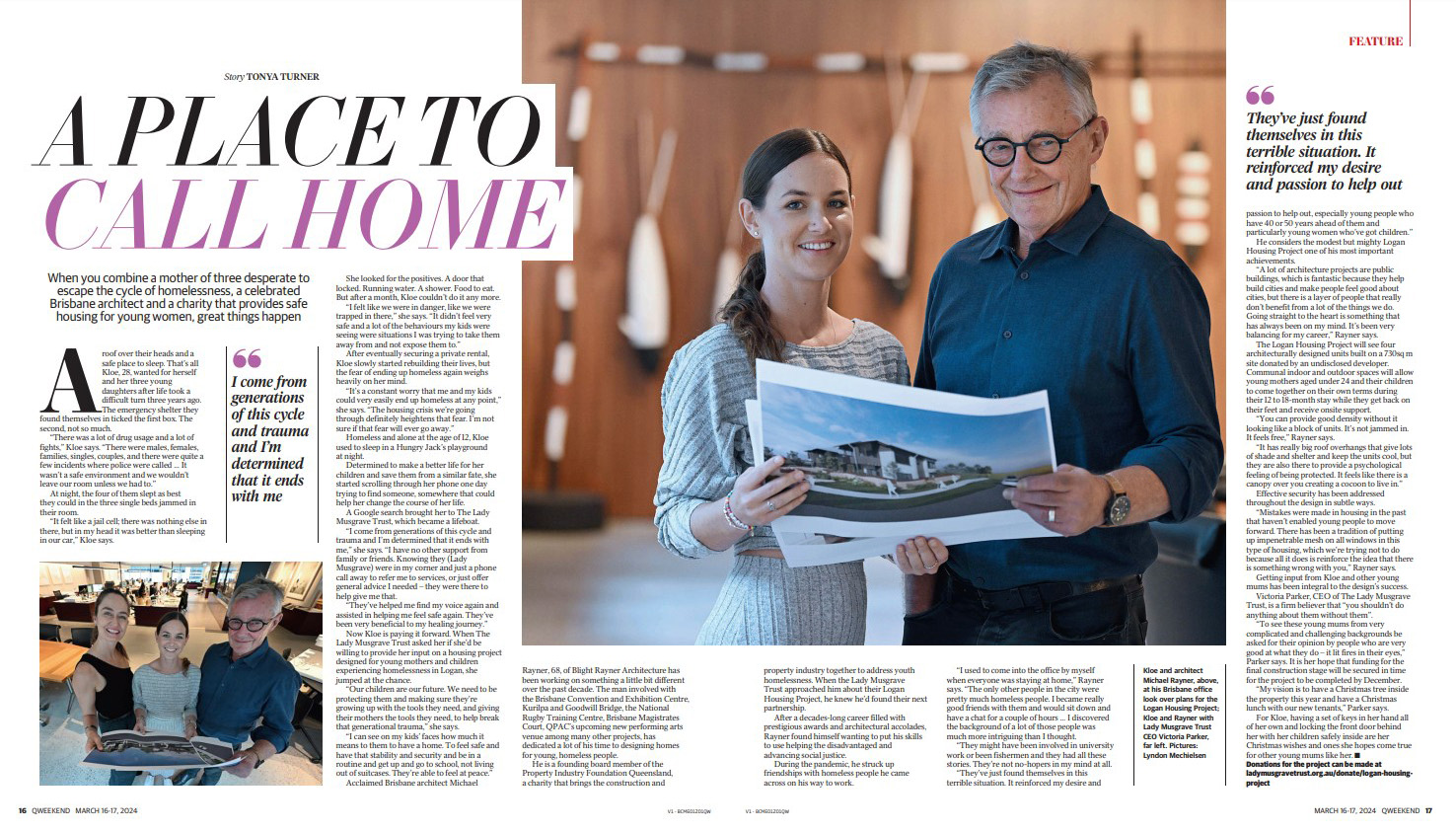A PLACE TO CALL HOME
Article by Tonya Turner, published in the QWeekend, The Courier Mail on the weekend of the 16-17 March 2024
WHEN YOU COMBINE A MOTHER OF THREE DESPERATE TO ESCAPE THE CYCLE OF HOMELESSNESS, A CELEBRATED BRISBANE ARCHITECT AND A CHARITY THAT PROVIDES SAFE HOUSING FOR YOUNG WOMEN, GREAT THINGS HAPPEN
A roof over their heads and a safe place to sleep. That’s all Kloe, 28, wanted for herself and her three young daughters after life took a difficult turn three years ago. The emergency shelter they found themselves in ticked the first box. The second, not so much.
“There was a lot of drug usage and a lot of fights,” Kloe says. “There were males, females, families, singles, couples, and there were quite a few incidents where police were called … It wasn’t a safe environment and we wouldn’t leave our room unless we had to.”
At night, the four of them slept as best they could in the three single beds jammed in their room.
“It felt like a jail cell; there was nothing else in there, but in my head it was better than sleeping in our car,” Kloe says.
She looked for the positives. A door that locked. Running water. A shower. Food to eat. But after a month, Kloe couldn’t do it any more.
“I felt like we were in danger, like we were trapped in there,” she says. “It didn’t feel very safe and a lot of the behaviours my kids were seeing were situations I was trying to take them away from and not expose them to.”
After eventually securing a private rental, Kloe slowly started rebuilding their lives, but the fear of ending up homeless again weighs heavily on her mind.
“It’s a constant worry that me and my kids could very easily end up homeless at any point,” she says. “The housing crisis we’re going through definitely heightens that fear. I’m not sure if that fear will ever go away.”
Homeless and alone at the age of 12, Kloe used to sleep in a Hungry Jack’s playground at night.
Determined to make a better life for her children and save them from a similar fate, she started scrolling through her phone one day trying to find someone, somewhere that could help her change the course of her life.
A Google search brought her to The Lady Musgrave Trust, which became a lifeboat.
“I come from generations of this cycle and trauma and I’m determined that it ends with me,” she says. “I have no other support from family or friends. Knowing they (Lady Musgrave) were in my corner and just a phone call away to refer me to services, or just offer general advice I needed – they were there to help give me that.
“They’ve helped me find my voice again and assisted in helping me feel safe again. They’ve been very beneficial to my healing journey.”
Now Kloe is paying it forward. When The Lady Musgrave Trust asked her if she’d be willing to provide her input on a housing project designed for young mothers and children experiencing homelessness in Logan, she jumped at the chance.
“Our children are our future. We need to be protecting them and making sure they’re growing up with the tools they need, and giving their mothers the tools they need, to help break that generational trauma,” she says.
“I can see on my kids’ faces how much it means to them to have a home. To feel safe and have that stability and security and be in a routine and get up and go to school, not living out of suitcases. They’re able to feel at peace.”
Acclaimed Brisbane architect Michael Rayner, 68, of Blight Rayner Architecture has been working on something a little bit different over the past decade. The man involved with the Brisbane Convention and Exhibition Centre, Kurilpa and Goodwill Bridge, the National Rugby Training Centre, Brisbane Magistrates Court, QPAC’s upcoming new performing arts venue among many other projects, has dedicated a lot of his time to designing homes for young, homeless people.
He is a founding board member of the Property Industry Foundation Queensland, a charity that brings the construction and property industry together to address youth homelessness. When the Lady Musgrave Trust approached him about their Logan Housing Project, he knew he’d found their next partnership.
After a decades-long career filled with prestigious awards and architectural accolades, Rayner found himself wanting to put his skills to use helping the disadvantaged and advancing social justice.
During the pandemic, he struck up friendships with homeless people he came across on his way to work.
“I used to come into the office by myself when everyone was staying at home,” Rayner says. “The only other people in the city were pretty much homeless people. I became really good friends with them and would sit down and have a chat for a couple of hours … I discovered the background of a lot of those people was much more intriguing than I thought.
“They might have been involved in university work or been fishermen and they had all these stories. They’re not no-hopers in my mind at all. “They’ve just found themselves in this terrible situation. It reinforced my desire and passion to help out, especially young people who have 40 or 50 years ahead of them and particularly young women who’ve got children.’’ He considers the modest but mighty Logan Housing Project one of his most important achievements.
“A lot of architecture projects are public buildings, which is fantastic because they help build cities and make people feel good about cities, but there is a layer of people that really don’t benefit from a lot of the things we do. Going straight to the heart is something that has always been on my mind. It’s been very balancing for my career,” Rayner says.
The Logan Housing Project will see four architecturally designed units built on a 730sq m site donated by an undisclosed developer. Communal indoor and outdoor spaces will allow young mothers aged under 24 and their children to come together on their own terms during their 12 to 18-month stay while they get back on their feet and receive onsite support. “You can provide good density without it looking like a block of units. It’s not jammed in. It feels free,” Rayner says.
“It has really big roof overhangs that give lots of shade and shelter and keep the units cool, but they are also there to provide a psychological feeling of being protected. It feels like there is a canopy over you creating a cocoon to live in.”
Effective security has been addressed throughout the design in subtle ways.
“Mistakes were made in housing in the past that haven’t enabled young people to move forward. There has been a tradition of putting up impenetrable mesh on all windows in this type of housing, which we’re trying not to do because all it does is reinforce the idea that there is something wrong with you,” Rayner says.
Getting input from Kloe and other young mums has been integral to the design’s success.
Victoria Parker, CEO of The Lady Musgrave Trust, is a firm believer that “you shouldn’t do anything about them without them”.
“To see these young mums from very complicated and challenging backgrounds be asked for their opinion by people who are very good at what they do – it lit fires in their eyes,” Parker says. It is her hope that funding for the final construction stage will be secured in time for the project to be completed by December.
“My vision is to have a Christmas tree inside the property this year and have a Christmas lunch with our new tenants,” Parker says.
For Kloe, having a set of keys in her hand all of her own and locking the front door behind her with her children safely inside are her Christmas wishes and ones she hopes come true for other young mums like her.
Donations for the project can be made at ladymusgravetrust.org.au/donate/logan-housing-project


